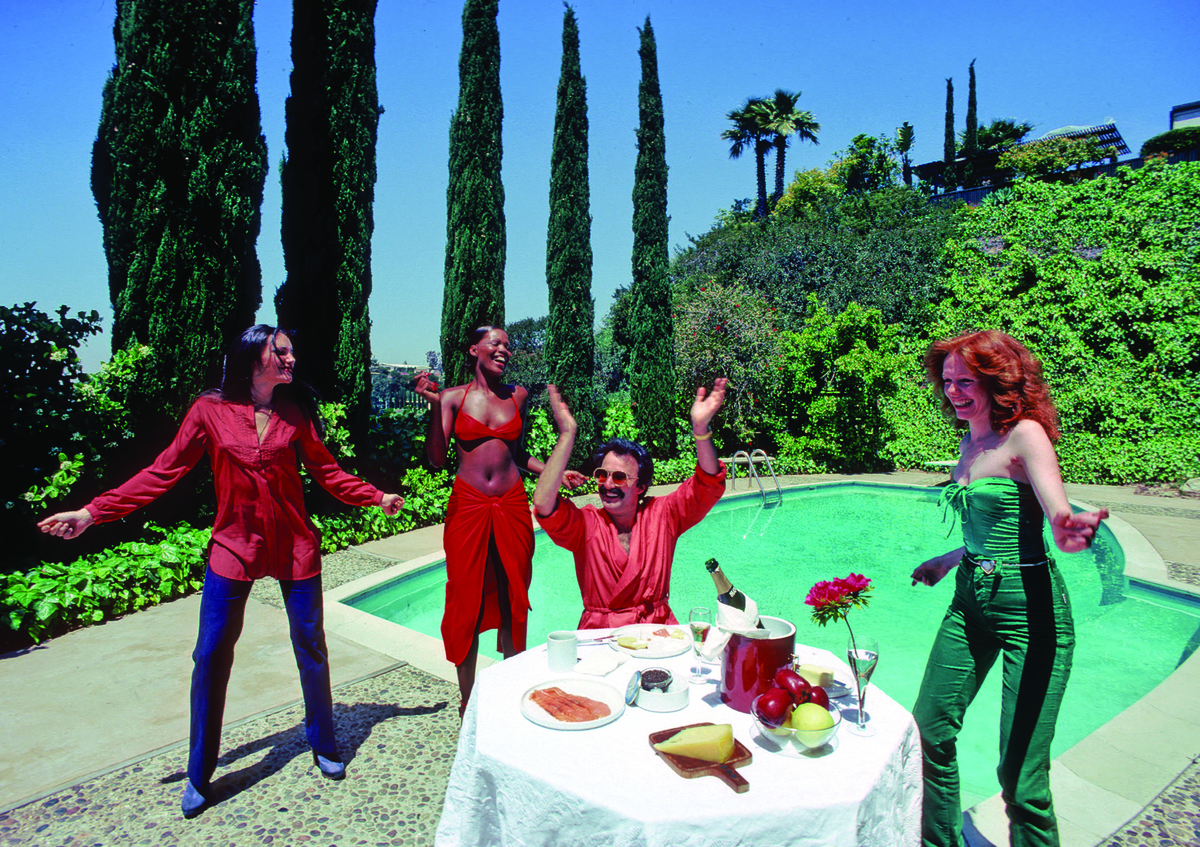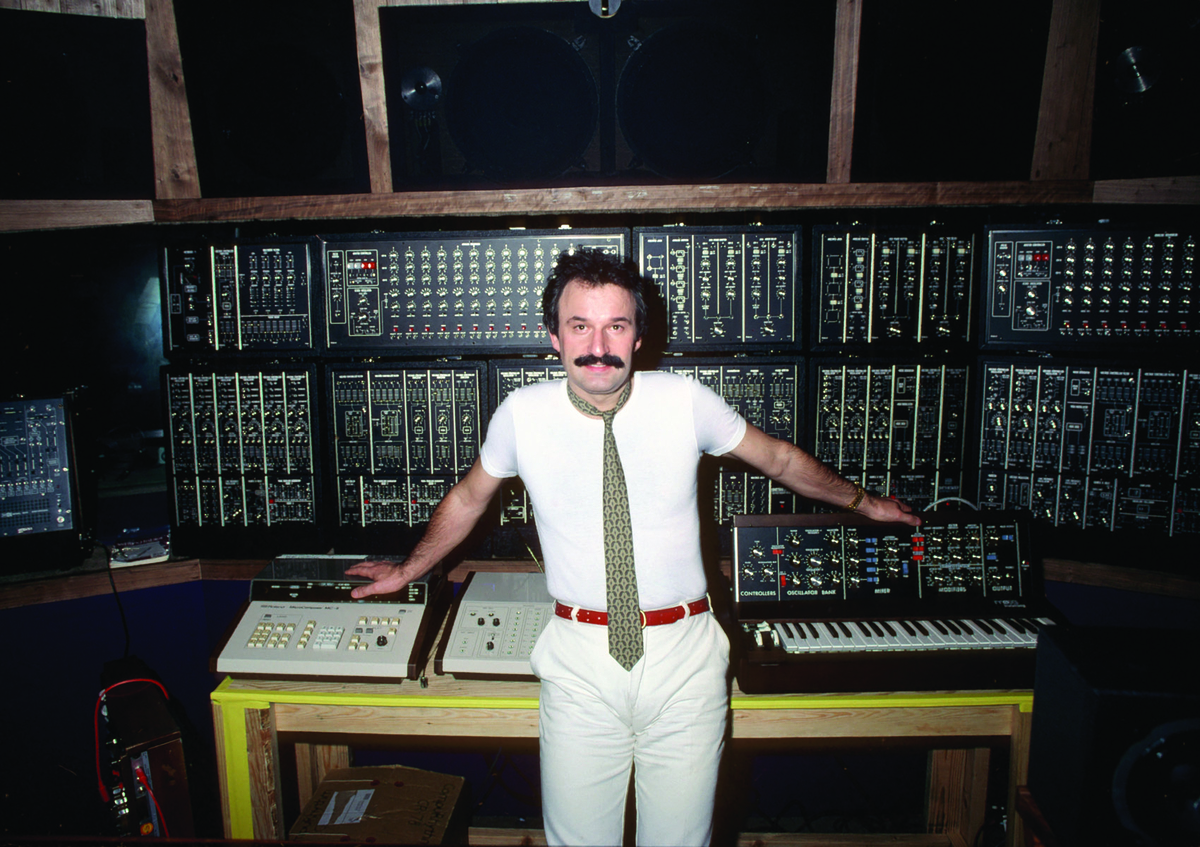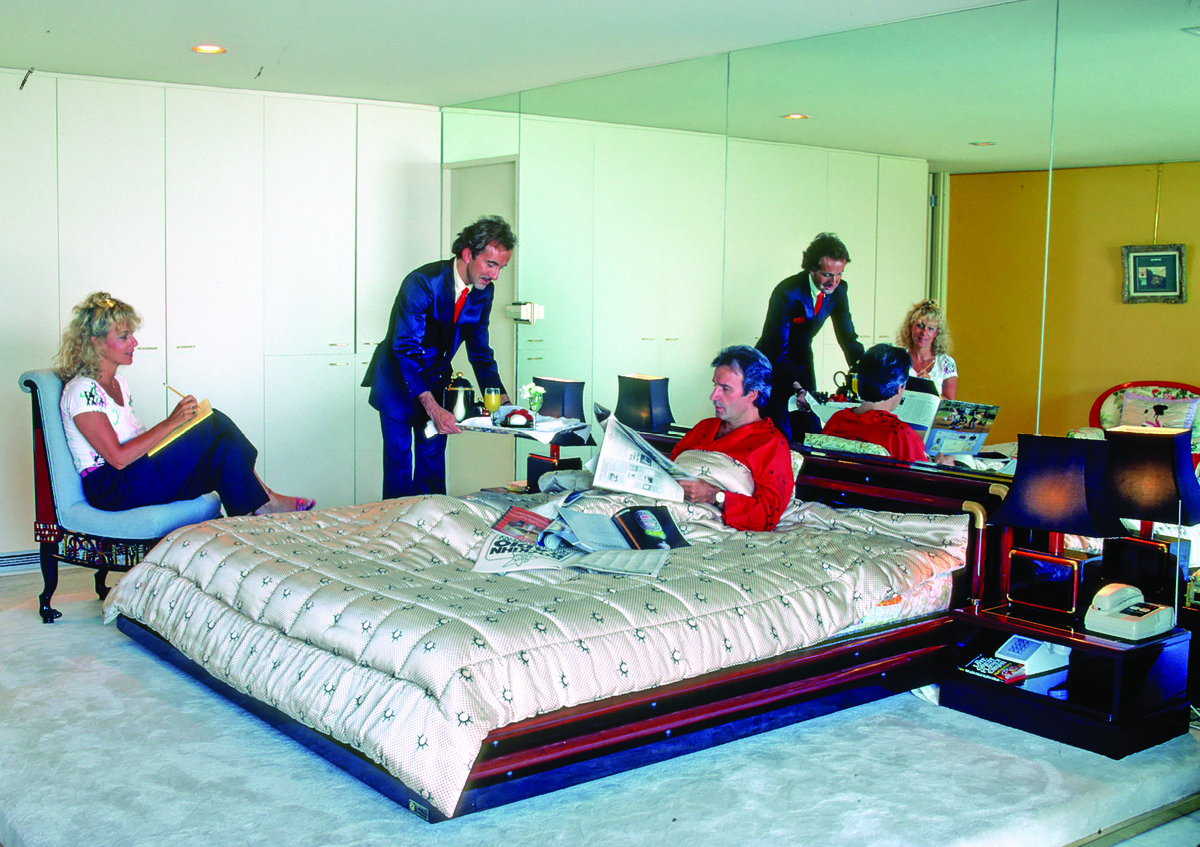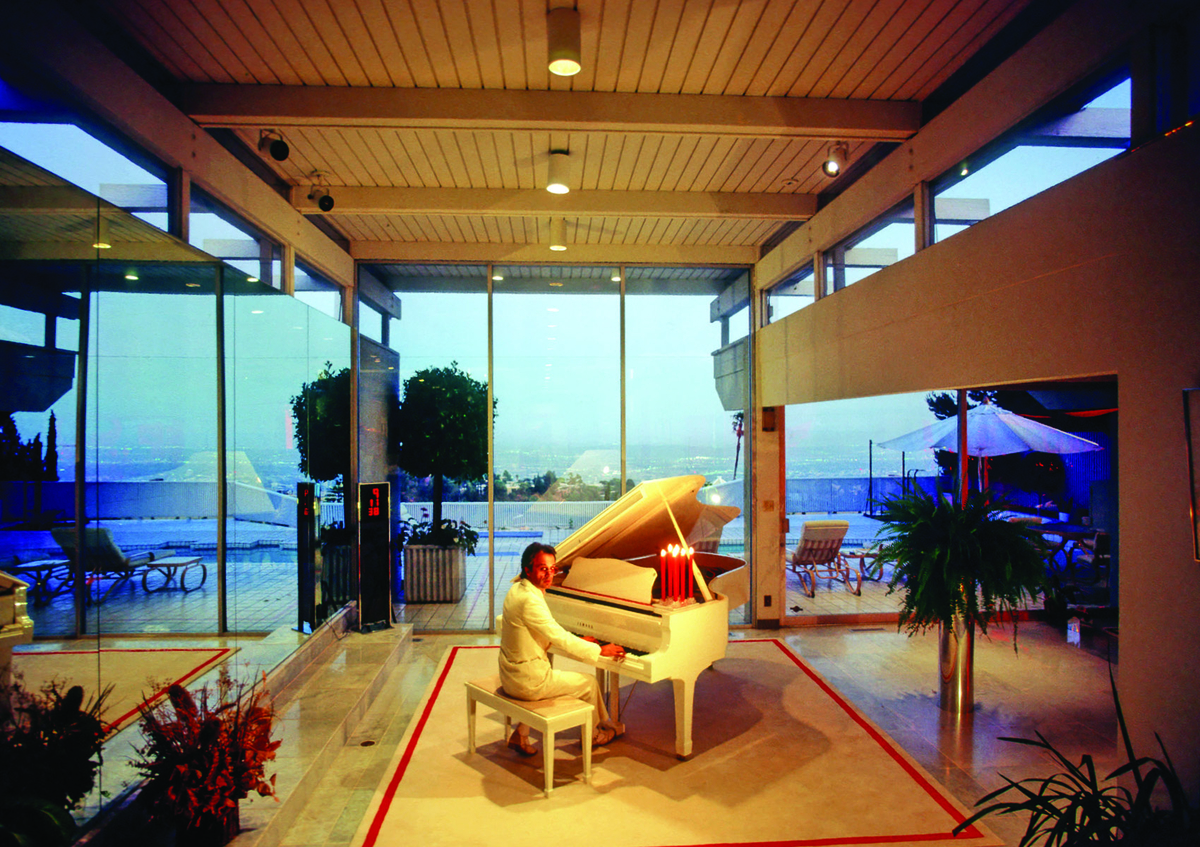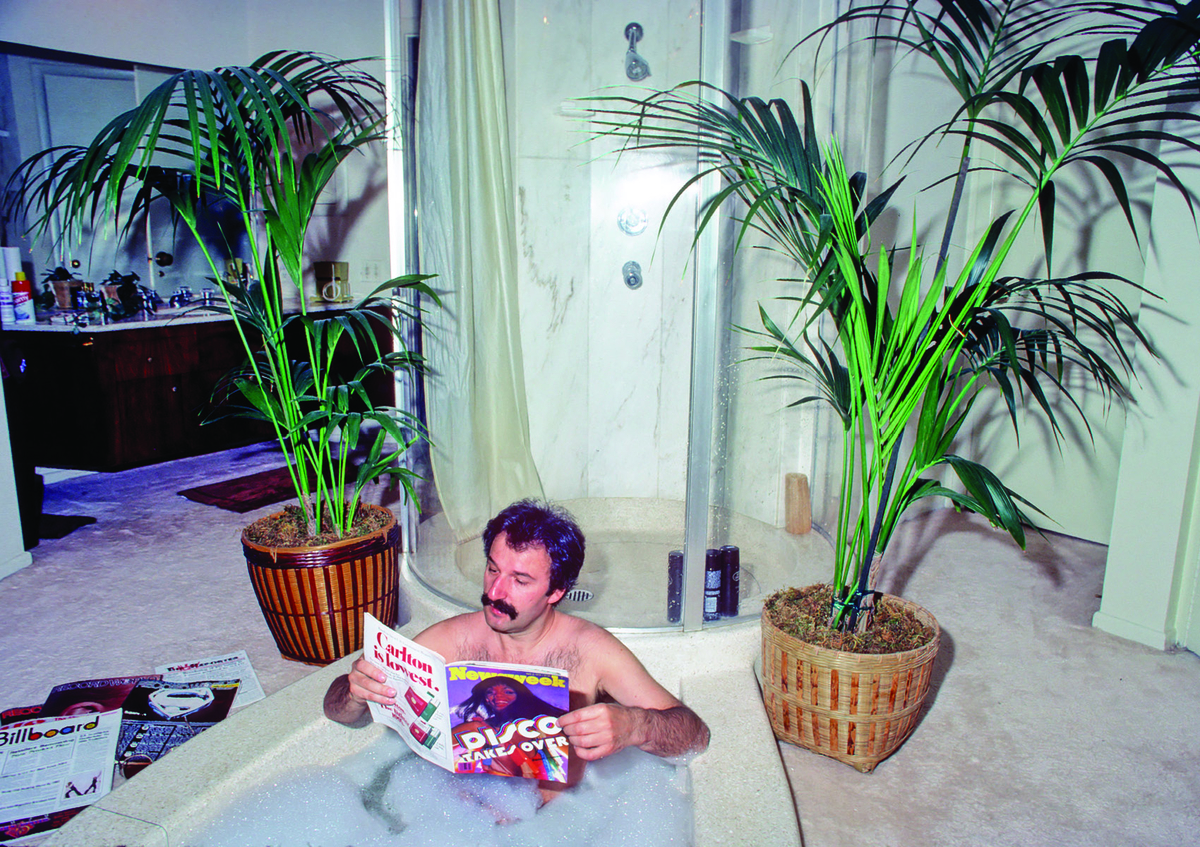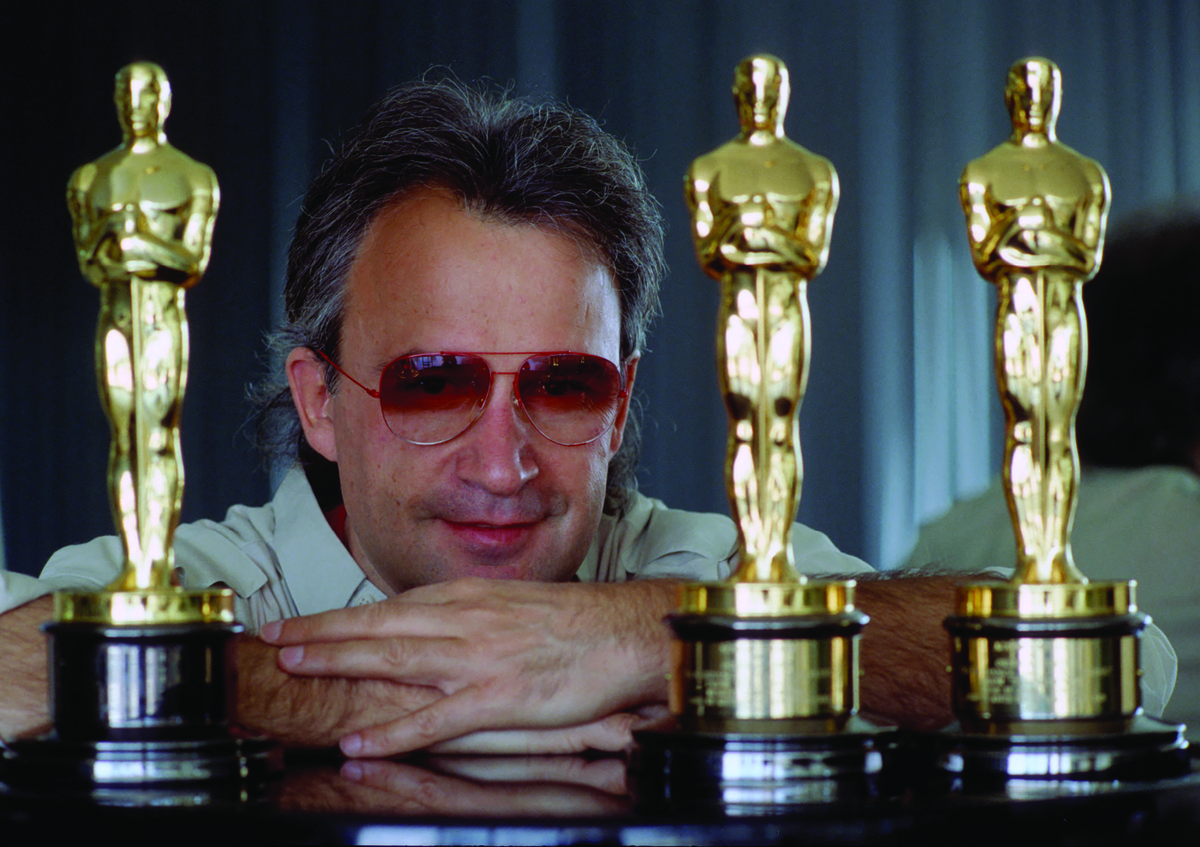In February 1975, Giorgio Moroder was asleep in his Munich apartment when the phone rang. The record producer–composer picked up the receiver to hear the nasal voice of Casablanca Records’ head Neil Bogart on the other end.
“Make it longer,” Bogart commanded.
He was talking about a song Moroder had played for him days earlier at the Midem “new music” convention in Cannes: a slow, sexy number Moroder co-wrote with its singer, Donna Summer. “Love to Love You Baby” was a breathy homage to Serge Gainsbourg’s infamous single “Je T’Aime … Moi Non Plus,” where the French pop star can be heard (allegedly) making love to actress Jane Birkin. Moroder asked Summer to think of a persona while she sang, and she chose Marilyn Monroe and her whispering rendition of “Happy Birthday” to President Kennedy.
Entranced by its sensual falsetto and languid pace, Bogart went crazy for “Love to Love You Baby,” brought it back to Los Angeles, and played it during a party at his Beverly Hills mansion. The party turned into an orgy, and the song was so hot that Bogart played it over and over. The only annoying part was that some naked person had to get up and start the song again when it reached the end of its three and a half minutes.
“How long is long?” Moroder asked.
“Think of filling up an album side. Like ‘In-a-Gadda-Da-Vida,”’ Bogart answered, referring to hard-rock group Iron Butterfly’s 17-minute, five-second opus.
In the morning, Moroder told Summer about Bogart’s request. “Giorgio, how am I supposed to come up with lyrics for another 14 minutes of the song?” she asked. Moroder had a solution. That night in the studio, he lit a few candles, dimmed all the lights, and told Summer to improvise. “And make it sound sexy,” he instructed her. Summer certainly did, and ultimately the sighs and moans of a woman having an orgasm filled in the lyrics gap.
This past summer, 44 years later, at the Lowlands Festival in the Netherlands, Giorgio Moroder looks out at a rain-soaked crowd of 20,000-plus music fans who are there to see headliners such as Billie Eilish or Boy Pablo, not to hear a 79-year-old record-producing D.J. who knows his way around a synthesizer. However, when Moroder and his live band play the first notes of “Love to Love You Baby,” the crowd screams and starts to sing along. It is this old material that brings this young crowd to a communal roar.
Three Oscars, Four Grammys, One Lady Gaga
For those of us who love disco, Giorgio Moroder is our Sam Phillips, our Rick Rubin, our Timbaland. For those who hate disco, Moroder is the anti-Christ—Moroder is the reason disco music succeeded and one of the reasons it failed. He created the most identifiable, most populist sound of the genre and has won three Oscars, four Grammys, and four Golden Globes. His music is so reviled by some that they actually set his albums on fire and started riots. Still, many people don’t know anything about Giorgio Moroder, which I always found a disappointment. I learned who he was when I was just an eager New York high schooler with the occasional side ponytail and Fiorucci glitter gel on my face. In 2004, I started working on a profile of Moroder, because I was determined to give him a spotlight—whether he liked it or not.
Throughout the process, Moroder was reluctant to be interviewed, while everyone else I asked, including the late, great Donna Summer, said yes right away. I convinced him to speak with me, both in person at the Beverly Hills Hotel and on the phone, but he was never truly comfortable. “I’m not in focus anymore,” he told me back then, cringing when the Polo Lounge hostess fawned over him. “Honestly, I don’t know why anyone would be interested in reading about me.” Moroder was pretty self-denigrating, and wouldn’t even put on his old songs: “If I listen to them for too long, I become nervous.”
For those of us who love disco, he is our Sam Phillips, our Rick Rubin, our Timbaland.
But, after decades of semi-retirement, Moroder has shaken off his nerves and got back in the groove, working with artists such as Daft Punk, Lady Gaga, Britney Spears, Sia, and Kylie Minogue—and he’s even started to tour as a D.J. with a live band. His resurgence was cemented last August, when Ariana Grande joined Barbra Streisand onstage in Chicago for a surprise duet of the Moroder-produced “No More Tears (Enough Is Enough),” with the young pop star belting out Donna Summer’s part. “She was very brave. It’s not an easy song to sing,” Moroder told me on the phone from Italy.
Moroder never took the easy road as producer, either. As one of the principal architects of disco, he made dance-club songs radio-friendly and gave them a futuristic sound. Moroder’s innovations with synthesizers, vocoders, and other computerized music equipment are still used today, from hip-hop to E.D.M. His work with artists such as Debbie Harry, David Bowie, and Summer was groundbreaking. His scores for American Gigolo, Midnight Express, and Scarface compelled Hollywood soundtracks to reflect contemporary sounds. And with two of his singles with Summer, “Love to Love You Baby” and “I Feel Love,” Giorgio Moroder and his Eurodisco sound had a profound influence on the course of popular music.
“Giorgio had funky, R&B kind of roots, mixed with a vision of the future,” said Nile Rodgers, founder of the group Chic and producer for Madonna, David Bowie, and many others. “It sounded clever and innovative, almost on the level of jazz pioneers like Charlie Parker. When I wrote ‘I Want Your Love’ for Chic, that was me trying to imitate on guitar what Giorgio and these guys were doing with keyboards. I said, ‘This is the funkiest, tightest person that has ever walked this planet.’ I didn’t think that any musician could play with that kind of virtuosity. I had no idea that there were computers running it. I was shocked.”
Enter Donna Summer
Giovanni Giorgio Moroder was born April 26, 1940, the second of four boys, in the northern town of Ortisei, Val Gardena, Italy. While he briefly studied architecture, Moroder’s passion was playing guitar, and he toured Europe in some unknown cover bands. Moroder settled in Berlin, and in 1969 he had his first hit with “Looky Looky,” and in 1972 a bigger one with “Son of My Father,” recorded by the band Chicory Tip. Both songs were in a style called Schlager, similar to American “bubblegum” music—think “Yummy Yummy Yummy” by the Ohio Express or the Archies’ “Sugar, Sugar.”
Moroder moved to Munich, just when a new revolution had been hatched called “discotheque music,” imported from Paris. Discothèques (record libraries), like Castel’s and Chez Régine, had become the smoky, sultry dance clubs of choice. Similar places opened in New York and London, but the music they played hadn’t caught on, even though Billboard thought enough of the trend to launch a dance-music chart in 1965. Then some of the hippie ideology and psychedelic tripping soured after Altamont (and, a few years later, Watergate), and some fans were growing weary of depressing folk music and protest rock. The early 1970s were ripe for a new sound to emerge, something up-tempo, happier, and less emotionally taxing.
Around the same time, Moroder became involved with an experimental electronic movement led by Teutonic rock groups such as Kraftwerk, Can, and Faust. He wanted to get away from the Schlager sound. In 1973, along with his new producing partner, Pete Bellotte, Moroder founded Musicland Studios beneath Arabella House, a hotel outside the old Munich airport. The studio, a low-key venue with wood paneling and deep-red curtains, was an ideal location to make albums, so groups like Queen and Led Zeppelin came to Musicland so they could record all night, go upstairs to the hotel, and sleep all day, never having to leave the premises. The money was great for Moroder, but running a studio cramped his own musical ambition. “I mainly had the studio built for myself, but whenever somebody like the Rolling Stones would call and say, ‘We’ll come in next Monday,’ I would have to leave.”
His scores for American Gigolo, Midnight Express, and Scarface changed Hollywood soundtracks.
One day Moroder and Bellotte were looking for a singer to record a demo for the group Three Dog Night. A friend recommended a 23-year-old American named Donna Gaines Sommer, a Boston native who had moved to Munich to star in a local production of the musical Hair. Moroder thought the new girl had a terrific, clear voice with perfect pitch, and asked her to record a song called “The Hostage,” which became a European hit. When the record company misspelled her last name of Sommer as Summer, Moroder insisted she keep it that way. Moroder insisted on a lot of things, but the singer didn’t mind. She was juggling a lot, including motherhood (a daughter named Mimi) and an abusive relationship with her then husband, failed actor Helmuth Sommer. For Summer, Moroder’s guiding hand was just what she needed.
“Giorgio enabled me not to be a victim of my circumstances, and he always made me feel that I had someone [to turn to],” Summer said. “He didn’t take advantage of me physically or demand anything from me. He was just there.”
When Summer was trying to separate from her jealous and adulterous husband, she knew in a crisis she could take Mimi and sleep in a guest room at Moroder’s apartment. Moroder also supported her financially before she had earned a single pfennig, and when she started making money he put it in a Swiss bank account for her and wouldn’t let her spend it. “When I’d say, ‘Giorgio, I need to pay the rent,’ he would bring the money to me. He wasn’t just caring because of something for him to gain—he wanted to make sure I was O.K.”
Moroder also never treated Summer merely as talent; he brought her into the producing process and taught her about songwriting. When she came to him with a song title called “I Would Love to Love You,” Moroder encouraged her to write the rest of the song that would become “Love to Love You Baby.” They were pleased with the results, but neither was prepared for the craze they would start.
After the 16-minute, 49-second version came out, no one thought the racy, lengthy “Love to Love You Baby” would get airplay. But New York D.J. Frankie Crocker started playing it after midnight and encouraged others to do the same—basically to take a bathroom break. “Love to Love You Baby” was also a huge hit at discos, building the frenzy on the dance floor to grand heights until, exhausted, the night was over. The song hit No. 2 on the Billboard charts in 1975 (just behind Paul Simon’s “50 Ways to Leave Your Lover”), and its overt ode to masturbation, including a suggestive album cover of Summer, made it notorious.
Moroder never treated Summer merely as talent; he brought her into the producing process.
The basic rap on disco was that it was superficial and soulless, but arguably it was as much about peace and love as protest songs of the 60s. “Disco was the most integrated moment in music history,” said Dave Marsh, one of the music critics who defended disco back then. “But mixing on the dance floor on Saturday night—all those people went home to segregated lives. Sunday mornings, churches didn’t integrate. But the clubs did.”
Moroder was pretty oblivious to the politics of his music, even though he was progressive about race and culture within his work. Unlike many producers, he didn’t insist that Donna Summer had to sing in an R&B style just because she was black. “He just said, this is where I think your voice lends itself,” Summer remembered, “so let’s be clear and make it fantastic.”
Moroder also embraced a new concept: the producer as artist. Singers, musicians, and instruments were interchangeable and equal in importance. This was different from rock ’n’ roll, which had been more about recording live acts for those who couldn’t get to a club or an arena. This should have been a problem for Summer, known as the “Queen of Disco” for many reasons, but she completely understood.
“I was using my voice more as a sound instrument than as a singer, almost like using myself like a synthesizer,” Summer said. “Giorgio, Pete, and I were enamored with what we could do with sound. I don’t think we knew that we were forging a new pathway. We were just being ourselves.”
“I Wanted That Stabby … Robotic Sound”
The year 1977 represented the height of disco fever, when Studio 54 opened and Saturday Night Fever was released. Moroder and Summer released a concept album in May called I Remember Yesterday with material inspired by the 40s, 50s, 60s, 70s, and “the future”—and the futuristic song was called “I Feel Love.” Moroder remembered loving the sequenced, unreal sound produced by the Moog synthesizer, which he had tried years earlier when it was just a prototype. He thought it would give this song a space-age eeriness.

“I wanted that stabby, kind of robotic sound,” Moroder said. “If [a human being] would have played it, it probably wouldn’t have worked as well.” Moroder and Bellotte layered Summer’s ghostly soprano vocals on top of a metronomic bass line, a mournful foghorn effect, and a supernatural chorus. The sound came from the combination of Summer, the synthesizer, the drum machine, and nothing else.
There were other popular electronically influenced works (Pink Floyd’s The Dark Side of the Moon, Mike Oldfield’s Tubular Bells), but “I Feel Love,” with its all-electronic orchestration and arrangement, was the song that started the techno and Hi-NRG movements. According to pop-music legend, David Bowie and Brian Eno came to Musicland Studios in 1977 to work on their experimental albums Low and Heroes, hoping to capture the “synth pop” sensibility of Kraftwerk and other bands. One day, Eno ran into the studio with “I Feel Love” in his hand. He said to Bowie, “I have heard the future.”
The combination of songs like “I Feel Love,” with sirens, whistles, strobes, gyrating dancers, and drugs, was the paradigm of the disco experience. While Moroder helped shape this hedonistic world, he did not indulge himself. The producer only went to clubs to check out the latest songs, and neither he, Summer, nor Bellotte did drugs, smoked, or drank to excess, which partly explains their output of seven albums (two were double albums) in five years. “I don’t know,” Moroder said offhandedly, “I never had the urge.” Moroder’s urge was for all things electronic; his 1977 album, From Here to Eternity, even had a sentence on the back cover announcing proudly, “Only electronic keyboards were used on this recording.”
American Gigolo and “Call Me”
In 1978 the director Alan Parker had finished a movie called Midnight Express, starring Brad Davis as a young American caught with hashish and sentenced to a particularly inhospitable Turkish prison. He heard “I Feel Love” and thought Moroder’s mechanical, futuristic sound would add to the film’s danger and suspense. Moroder’s soundtrack won him an Oscar for best score. He would later win two more statuettes for best song, for Irene Cara’s “Flashdance … What a Feeling,” in 1984, and for Berlin’s “Take My Breath Away,” from 1986’s Top Gun.
Moroder was a master at holding people’s attention and taking them for a ride, only now he had to hold them rapt and still in a movie theater, rather than getting them to move on a dance floor. The film composer Hans Zimmer told me that Moroder’s score for Midnight Express altered the way soundtracks were composed. “[The music] when they go to the airport … wow,” Zimmer said. “By creating this loop of repeating notes, [Giorgio] added an incredible amount of tension to the scene, because he wasn’t signaling what was going to happen next, and being electronic made it so unpredictable.”
Moroder’s soundtrack for Midnight Express won him an Oscar. He would later win two more statuettes for best song, for “Flashdance … What a Feeling” and “Take My Breath Away.”
In 1980, Moroder collaborated with Debbie Harry and Blondie on “Call Me,” the main theme for Paul Schrader’s American Gigolo, and worked with David Bowie on “Putting Out the Fire” for the 1982 movie Cat People. Then came the feverish score to Brian De Palma’s 1983 film, Scarface. “The music really does drive the film,” said Dave Marsh. “It’s part of the loco energy that Pacino and De Palma got going there.”
As Moroder shifted his attention away from disco, so did the audience. “Discofying” everything seemed to be the way to make a quick dollar, but with projects like The Ethel Merman Disco Album and Rick Dees’s Disco Duck, disco became watered down, monotonous, and, well, just plain bad. In 1979, Moroder, Summer, and Bellotte released one more successful album for Casablanca Records called Bad Girls. But on July 12 of that year, Steve Dahl, a D.J. for WLUP in Chicago, exploded a 12-foot-high pile of disco records between games of a Chicago White Sox–Detroit Tigers doubleheader at Comiskey Park; the field caught on fire, the crowd was revved up and scared, and the “Disco Sucks” movement took hold.
Unfortunately for Moroder, his Eurodisco sound was the one the disco-hating public hated the most; one radio D.J. played Donna Summer’s Moroder-produced “Last Dance” nonstop for 24 hours to announce his station’s return to rock from an all-disco format. “The quality got lost and the repetition [made it bad],” Moroder said. “Rock has ballads, then has fast combinations. The difference with disco is that it just has a very repetitive, upbeat tempo. Also, the non-gay population couldn’t face the unconventionality of the music, the acceptance of various lifestyles. But repetition was its biggest problem.”
For Moroder and Summer, it was the end of an era as well. Summer filed a lawsuit against Neil Bogart and Casablanca for mismanagement, and left the label for Geffen Records. She recorded two albums with Moroder and Bellotte for Geffen—one was released; one was not. Then, to Summer’s and Moroder’s dismay, the label decided she should work with producers like Quincy Jones, and Moroder and Bellotte were dropped. Still, the trio never stopped being friends.
An Artist in the Art of Living
“In German there’s a word, ‘Lebenskunstler,’ which means ‘an artist of life,”’ said Donna Summer. “Giorgio is an artist in the art of living.” For Moroder, being a life artist took different forms, some that he mastered, others that he did not. In 1984 he restored Fritz Lang’s 1927 silent-film masterpiece, Metropolis, adding a soundtrack with songs by Freddie Mercury, Pat Benatar, Billy Squier, and Bonnie Tyler. The film was a complete bomb. “I made mistakes with costly colorization,” Moroder explained, “plus the songs were dated. It’s hard to sell a silent film.”
Another of Moroder’s passions was designing an over-the-top sports car with racing specialist Claudio Zampolli, with designers from Lamborghini. In 1988, Moroder and Co. introduced the Cizeta-Moroder V16T, a 16-cylinder car that claimed a top running speed of 204 m.p.h. and could accelerate from 0 to 60 in four seconds—with a sticker price of $600,000. It looked like a combination of a Lamborghini Countach, a Mazda Miata, and the Batmobile. They produced nine cars, in addition to the prototype, and sold six or seven (including two to the Sultan of Brunei). Then the luxury-car industry hit hard times. “It wasn’t exactly the best time to sell a $600,000 car,” Moroder said.
When I got back on the phone with him recently, I was struck by his ease on the call. He sounded vibrant and excited. “I’m happy to speak with you,” he said, with none of the trepidation he had had in our interviews from years ago. We talked about how he conquered his stage fright to start touring (“I told myself that I would only sing my two easiest songs and then the electronics and my band would do the rest”), how his wife, Francisca, has to practically pull him off the stage after his encores or he might play his entire music catalogue (“I’m just like James Brown,” he says, laughing), and how his son, Alex, an intern with famed tattooist Mark Mahoney, convinced his father to meet with a band he loved called Daft Punk, who had been paying homage (or, let’s say, appropriating) to Moroder’s sound. Suddenly he found himself with his fourth Grammy, for his work on Daft Punk’s 2013 dance album, Random Access Memories, which had a track with his voice called “Giorgio by Moroder.” The following year, Lady Gaga and Tony Bennett asked him to remix the song “I Can’t Give You Anything but Love” from their Cheek to Cheek jazz album.
One day Brian Eno ran into the studio with “I Feel Love.” He said to David Bowie, “I have heard the future.”
After that, Moroder was inspired to produce a new album, but was surprised by the changes in cutting a record. “Making this album was very different,” Moroder said about Déjà Vu, where he convinced Britney Spears to do a cover of Suzanne Vega’s “Tom’s Diner” and produced hits with Kylie Minogue (“Right Here, Right Now”) and the title track with Sia, which hit No. 1 on the Billboard dance charts. Moroder was used to the intimacy of long work sessions, spending weeks recording and collaborating with artists, particularly with Summer. This process was more immediate but much less familiar. While working with Sia on Déjà Vu, the duo never met in person. “I did tracks with part of her melody, and then Sia reworked part of it and sent it back via e-mail,” Moroder says. Not exactly circumstances where a producer could light candles and set the mood for an artist to feel comfortable enough to vocally set fire to a song.
Over the years, my fear of Moroder being overlooked has been dissipating. “I Feel Love” has been inducted into the National Recording Registry, and “Love to Love You Baby” made it into the Rock & Roll Hall of Fame’s list “500 Songs That Shaped Rock and Roll.” His music has been sampled and covered by many artists, including Beyoncé, Outkast, and Madonna. And a younger crowd is starting to appreciate Moroder’s work. As one critic wrote online about Moroder’s set in the 2019 Brussels Summer Festival, “We aren’t going to lie to each other. The name Giorgio Moroder did not make us leap for joy. And for good reason: he was royally unknown…. [But] this artist has clearly stolen our hearts. All generations present on Friday night will agree that the star of the Brussels Summer Festival was him.”
Moroder is cautiously excited concerning a jukebox musical about himself and his music; he didn’t say much about his character in the now closed Broadway show Summer: The Donna Summer Musical, where his fictional self is onstage briefly, and not in the most flattering way. However, he was thoughtful about the musical in general. “The way the songs were connected with strange interruptions of dialogue was awkward,” he says, “but the three girls who played Donna were just incredible.”
He became wistful when I asked about Summer’s death, from lung cancer, in 2012. “My wife and I had been in and out of touch with Donna, but were so happy when she took an apartment in our building in Los Angeles,” Moroder says. “We spent a lot of time with her and noticed she was losing weight, but we had no idea how sick she was. I wanted to do a tour with her, but she said she couldn’t. And then she went back to Florida, and a few weeks later she was gone.”
Moroder is silent for a moment and clears his throat. “Donna did a lot for women,” he says. “It’s part of her legacy. Not just her singing, but her lyrics … she doesn’t get enough credit for her lyrics. ‘Love to Love You.’ ‘I Feel Love.’ ‘She Works Hard for the Money.’ I just want everyone to remember her.” I’m struck by the fact that he brings up “She Works Hard for the Money,” a song that he didn’t even produce. Giorgio Moroder gives credit where credit is due. And now he won’t be forgotten, either.
Susan Kittenplan is a writer based in New York City

